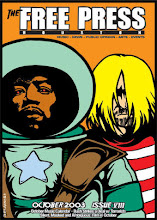The Soloist
There's a certain amount of ambivalence produced by the lyrical strains of The Soloist. If you're a fan of director Joe Wright, and who wouldn't be after Atonement, you'll marvel at his sense of visual elan. One sequence that reminds of his touch for visual splendor has a high angle tracking shot looking down at vagrant squalor. We pass over port-o-let after port-o-let each one filled with human debris sleeping in rags or smoking crack. It's not the tracking scene from Weekend but then again it's adventurous in a way not usually seen in American films.
Another brilliant scene has a mentally ill man hearing music and having the sound turn to light as he listens to the L.A. Philharmonic play at structural marvel Disney Hall (designed by Frank Geary). Indeed apart from the awesome visual flourishes the music score matches Wright's daring mise-en-scene by incorporating percussive sounds into the solo, chamber and symphonic instrumentation.
Then there's the rest of the film. At times preachy The Soloist almost grabs you by the lapels with a story that wavers between the world of journalism, the public eye and care of the homeless The Soloist keeps you glued to the screen through the intense performances of Robert Downey Jr. and Jamie Foxx as a L.A. Times reporter and a schizophrenic street musician. It's what surround these two that never engages the audience. An ex-wife (and boss) prone to sarcasm, raccoons that appear with the sole intention of messing with Downey, Foxx throwing fits of rage at the very moment he's being proactively helped to reintegrate into society. For every step The Soloist take forward as cinema it takes two steps backward as an entertaining movie.











